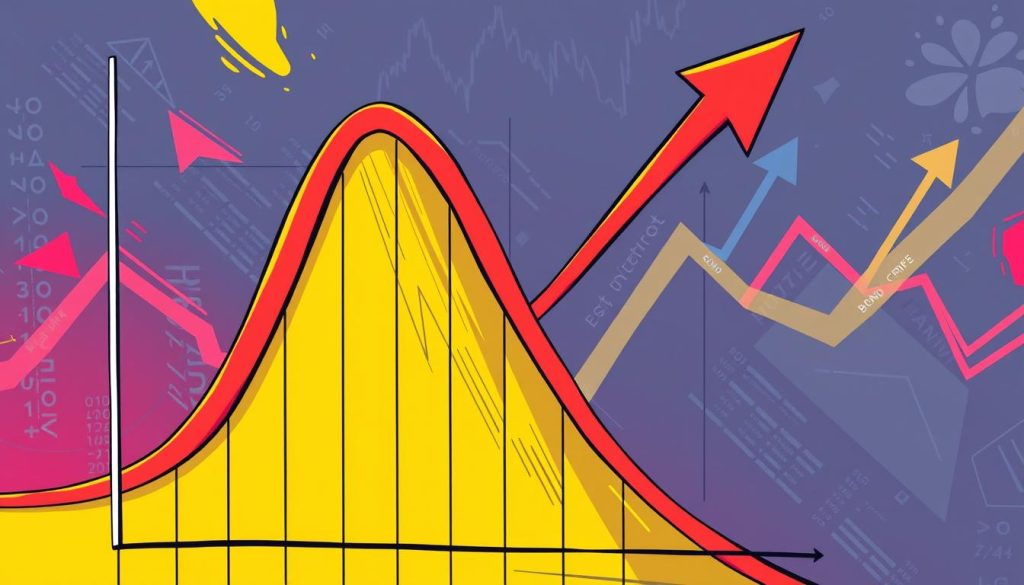For financial pros, knowing about bond yields is key. It helps in making smart investment choices and handling risks. Bond yields are the earnings from investing in bonds. They are crucial in finance. Learning about bond yields can boost your skills and improve your decision-making.
Key Takeaways
- Bond yields are the returns investors earn on their bond investments, and they differ from bond prices.
- Bonds can be purchased at a premium or a discount, which affects the yield the investor receives.
- Various components, such as coupon yield, current yield, and yield to maturity, are used to calculate bond yields.
- Understanding the relationship between bond yields and bond prices is essential for making informed investment decisions.
- Specialized training and webinars can help financial professionals deepen their knowledge of bond yields and related concepts.
- https://tunekong.com/diy-home-decor-masterclass-transform-any-space-with-simple-stunning-ideas-24/
Learning about bond yields helps you understand fixed-income investments better. It also helps in assessing credit risks and making informed decisions. The webinar series on bond yields is great for financial pros. It offers CPE credits, CMTA Specialized Training Hours, and MCLE credits for some sessions1.
With a fee of $95 for all 8 webinars, it’s a great deal. This program lets you dive deep into this important financial topic1.
What Is a Bond Yield?
Key Takeaways
Bond yield is the return an investor gets from a bond2. Bonds can be bought for more or less than their face value2. The current yield is the bond’s coupon rate divided by its market price2. As the bond’s price goes up, its yield goes down2.
Understanding Bond Yields
Bonds are seen as safe investments because their values don’t swing like stocks. They give investors a steady income and a fixed return. Investors get interest on the bond during its life and the full face value at the end.
Bonds can be bought for more or less than their face value, affecting the yield. The coupon yield is the bond’s annual interest rate from the start2. The current yield is the coupon yield divided by the market price2. The yield to maturity (YTM) is the total interest an investor earns if they hold the bond until it matures2.
The yield to call (YTC) looks at the bond’s yield if it’s called early2. The yield to worst (YTW) is the lowest possible return from a bond, between YTM and YTC2.
The Treasury Yield Curve shows interest rates for Treasury securities over different maturities2. It usually slopes up, meaning longer periods have higher yields2. Mortgage rates follow the 10-year U.S. Treasury note closely, showing a long-term relationship2.
Components of Bond Yield Calculations
Understanding bond yields involves looking at several key parts. These include the coupon yield, current yield, and yield to maturity (YTM)3.
Coupon Yield
The coupon yield is the annual interest rate set when the bond is first issued. This rate stays the same throughout the bond’s life4.
Current Yield
The current yield changes with the bond’s price and its coupon. If the bond’s price changes, so does its yield. To find the current yield, divide the bond’s annual coupon by its market price4.
Yield to Maturity (YTM)
Yield to maturity (YTM) is the rate that makes the present value of all a bond’s future cash flows equal to its current price. These cash flows include all coupon payments and the maturity value. Finding YTM involves a trial and error process, which can be done on a financial calculator4.
| Component | Definition |
|---|---|
| Coupon Yield | The annual interest rate established when the bond is issued, which remains the same for the lifetime of the bond. |
| Current Yield | Calculated by dividing the bond’s annual coupon payment by its market price, reflecting the bond’s current yield based on its price. |
| Yield to Maturity (YTM) | The interest rate that makes the present value of all a bond’s future cash flows equal to its current price, including coupon payments and maturity value. |
“Understanding the components of bond yield calculations is crucial for financial professionals to accurately assess the performance and risk of fixed-income investments.”
credit risk webinars
As the financial world changes, smart professionals are using credit risk webinars to get ahead. These online events are great for learning about credit risk management, loan default prediction, and credit scoring models5.
A series by the Federation and TCT Risk Solutions focuses on risk analytics and Basel III compliance. It covers topics like portfolio monitoring, stress testing, and fintech solutions. These webinars give a full view of the changing credit risk scene5.
Yield to Call (YTC)
For bond investors, knowing about Yield to Call (YTC) is key. YTC looks at how bonds can be called early, which affects returns6. It shows the yield if the bond is called on its first call date, giving a clearer picture of possible returns.
Yield to Worst (YTW)
Investors can also use Yield to Worst (YTW) for a safer look at returns. YTW looks at the lowest possible yield from all call dates, put dates, and the last maturity date. This gives a full view of what the bond could do6.

“The webinar series delves into credit skills under the current economic uncertainty to provide innovative risk assessment and decision-making strategies.”
Bond Yield vs. Bond Price
For those in credit risk webinars and management, knowing how bond yield and price relate is key. This knowledge helps in making smart choices with credit scoring models and risk analytics. It also aids in following Basel III compliance and stress testing7.
Bond price and yield move in opposite directions. When bond prices rise, yields fall, and vice versa7. This is crucial for anyone looking into fixed-income investments. Changes in interest rates can greatly affect a bond portfolio’s value7.
There are two main types of bond yields: market yield and book yield. Market yield is the return based on today’s bond price. Book yield is the return from the bond’s purchase price8. Knowing these differences helps investors evaluate their bond investments better and make smarter choices8.
| Yield Type | Description |
|---|---|
| Market Yield | The rate of return based on the current market price of the bond. |
| Book Yield | The rate of return based on the price at which the bond was purchased. |
Understanding bond yield and price helps professionals in credit risk and fintech. They can make better decisions in managing portfolios and using risk analytics78.

Bond Yield Relationships
Knowing how different bond yields relate to each other is key for credit risk management. It helps with predicting loan defaults and improving credit scoring models. This knowledge is vital for risk analysis and meeting Basel III standards. It also helps in monitoring portfolios and testing for stress9.
Discount Bond Yield Relationships
For discount bonds, the yields follow a specific order. The coupon rate is the lowest, followed by the current yield, then the Yield to Maturity (YTM), and finally the Yield to Call (YTC). This pattern is often shown as the “discount bond see-saw”10.
Premium Bond Yield Relationships
For premium bonds, the yield order is the opposite of discount bonds. The coupon rate is the highest, followed by the current yield, then the YTM, and lastly the YTC. This is also shown using the “bond see-saw” diagram10.
Understanding these yield relationships helps financial experts in credit risk webinars and management. It leads to better decision-making and improved portfolio monitoring and stress testing11.
Conclusion
Learning about bond yields is crucial for financial experts in credit risk management1213 and portfolio monitoring13. Understanding terms like coupon yield and yield to maturity helps guide your investment choices. It also aids in credit risk analysis.
By getting to know these ideas, you can use credit risk webinars1314 to your advantage. This knowledge helps you spot risks and make smarter decisions for your clients or institution. It’s key for tasks like predicting loan defaults, creating credit scores, or meeting Basel III standards13.
Keep up with industry changes and use advanced analytics to succeed. Building strong relationships with clients is also vital. With the right skills and tools, you can greatly improve your organization’s13 portfolio monitoring and14 stress testing. This will help your company grow and succeed over time.
FAQ
What is a bond yield?
A bond yield is the return an investor gets from a bond. Bonds are like loans to companies or governments. They are seen as safe because their value doesn’t swing like stocks do.
How can a bond be purchased?
You can buy bonds for more or less than their face value. This affects the yield they earn.
What is the coupon yield?
The coupon yield is the yearly interest rate set when the bond is first issued. This rate stays the same for the bond’s life.
What is the current yield?
The current yield changes with the bond’s price and its coupon. If the bond’s price changes, so does its yield. To find the current yield, divide the bond’s yearly interest by its market price.
What is the yield to maturity (YTM)?
Yield to maturity (YTM) is the interest rate that makes the present value of all a bond’s future cash flows equal to its current price. These cash flows include all the coupon payments and the final maturity value.
What is the yield to call (YTC)?
Yield to call (YTC) considers if the bond can be called early. It’s calculated assuming the bond is called on its first call date.
What is the yield to worst (YTW)?
Yield to worst (YTW) is a conservative yield measure. It looks at the lowest yield possible for every call date, put date, and maturity scenario.
How are price and yield related?
Price and yield are opposites. When a bond’s price goes up, its yield goes down. When the yield increases, the bond’s price decreases.
What is the difference between market yield and book yield?
Market yield shows the return based on current prices. Book yield is based on the original purchase price.
How do the yields differ for a discount bond vs. a premium bond?
For a discount bond, the yields order is: coupon, current yield, YTM, then YTC. For a premium bond, the order is reversed.

